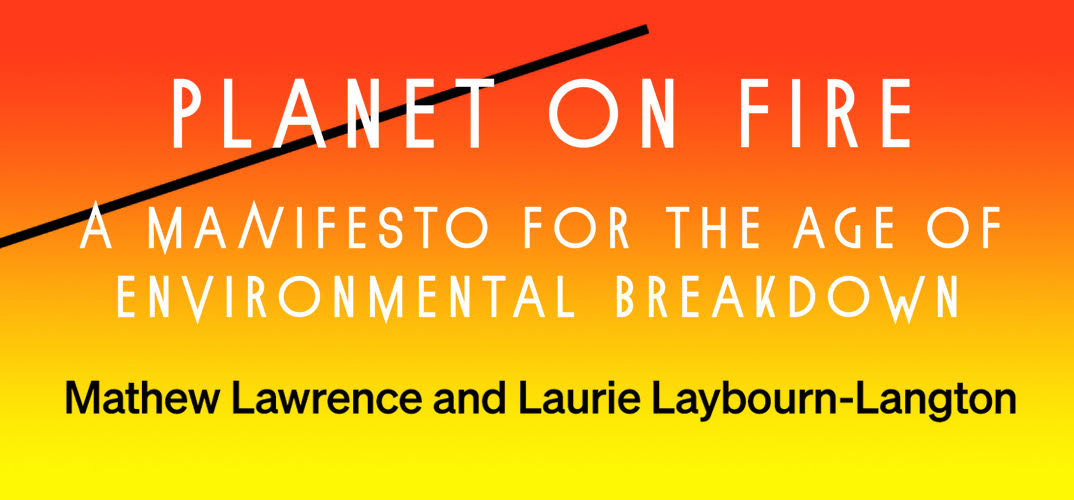By Mathew Lawrence and Laurie Laybourn-Langton
Verso 2021
Reviewed by James Fleming
Capitalism’s “solutions” to climate change are unfair or unworkable, when not outright disastrous. Using reusable coffee cups or paper straws won’t avert climate change. Telling ordinary people to buy expensive new electric cars as a way of saving the environment is today’s equivalent of “let them eat cake”, especially given the deficiencies or absence of public transport services virtually everywhere.
The science of climate change is increasingly understood and accepted. And naturally, serious political solutions are sought by those who want to avert environmental catastrophe. In this regard, books like Planet on Fire: A Manifesto for the Age of Environmental Breakdown are welcome.
Capitalist fairytales
The book begins by outlining the severity of the crisis in no uncertain terms. We must avoid global warming of 1.5°C above the average temperature that prevailed before the industrial revolution. This means that “Total global emissions must almost halve by 2030… and greenhouse gases must… end almost entirely by 2050”.
The authors, Mathew Lawrence and Laurie Laybourn-Langton, go on to show how, despite the stark changes required, capitalism continues to propel us in the wrong direction.
Planet on Fire criticises capitalism’s fairytale-like “solutions” to climate change (this tendency was also ridiculed in the 2021 movie Don’t Look Up). Many of the “solutions” propagated by entrepreneurs and their sycophants are either untested or not yet invented. Such technological “solutions”, where they are not fictional, are “too expensive… potentially running into the hundreds of trillions of dollars” (which of course, under capitalism, the working class would pay for through brutal attacks on living standards).
“Dangerously unregulated ‘geoengineering’ proposals, such as spraying reflective aerosols into the atmosphere, now litter the dreams of tech utopians”, the authors state. The book criticises the capitalist institutions which are “happy to see the world burn for maximising profit” and the centrist politics that is “floundering, lacking the ideas or political momentum to respond”.
The authors also highlight the dangers of denialism, ethnonationalism and “reactionary environmentalism”. They describe how “photos of deserted urban landscapes went viral” during the early days of the Covid pandemic, with the accompanying slogan: “Coronavirus is Earth’s vaccine. We’re the virus”.
A chilling example of ultra-reactionary ‘environmentalism’ is that of Patrick Crusius, a young Texan man who shared a document online in which he had written: “Our lifestyle is destroying the environment of our country… Everything I have seen and heard in my short life has led me to believe that the average American isn’t willing to change their lifestyle… so the next logical step is to decrease the number of people in America… If we can get rid of enough people, then our way of life can become more sustainable”. Within an hour of this document being uploaded, 20 people had been shot and killed by Crusius in a Walmart car park in El Paso. Crusius targeted people of colour, which he claimed was in ‘response to the Hispanic invasion of Texas’.
Easter Island and the ecocide narrative
The authors of Planet on Fire are at their best in their criticism of what is called the ’ecocide narrative’. To convey what the ecocide narrative is, they take us on a journey to Easter Island, an extremely remote part of the Pacific Ocean, where, according to a fallacy, the resources of this once-abundant island were exhausted through the short-term selfishness of its inhabitants, the Rapa Nui. In a matter of centuries, the Rapa Nui’s civilisation collapsed, and by the time European explorers discovered the island in 1722, its survivors had resorted to cannibalism, or so the tale goes. Those who espouse this story about Easter Island, and other fallacies like it, surmise that selfish “human nature” is the inevitable cause of environmental destruction on our planet. ‘Easter Island is earth writ small’. However, as the authors go on to explain, this version of Easter Island’s history is simply false.
The truth about Easter Island is that its resources were plundered by explorers from Europe on behalf of the burgeoning capitalist economies there. This began only around the 18th Century. The Rapa Nui society was an environmentally conscious one that managed its resources well. As Planet on Fire explains, Easter Island is not an example of the cynical notion of a selfish ‘human nature’, but an example of capitalism’s “three-step process of expansion, extraction and destruction”.
Of course, human activity is to blame for climate change, but which humans? ‘Ecocide narratives’ avoid or distort this vital question. Such narratives avoid addressing the fact that environmental destruction is overwhelmingly caused by the richest 1%, or that it is exacerbated by political decisions which prioritise the short-term wealth of the capitalist class over the health and wellbeing of the rest of humanity and the planet. Ecocide narratives conceal that we are not all equally to blame and that we do not share equal power and responsibility. It also ignores the history of resistance to industrial pollution and environmental destruction by ordinary working-class people and communities.
What the manifesto proposes
So, what solutions do Laurence and Laybourn-Langton propose in their manifesto?
“What we are arguing for then is a deep reimagining of society in the face of existential crisis… which for us means the collective effort to organise life through democratic power, with social control, not private rule shaping the institutions and technical systems that govern and reproduce life, repurposing them towards the pursuit of collective and individual human flourishing that is inseparable from a thriving natural environment.”
This is a noble, broadly anti-capitalist vision. This ‘reimagining’ of society is repeatedly referred to throughout the work. But it soon becomes disappointing that they do not go beyond these superficial descriptions to discuss how such changes could take place.
For example, they propose “an all-society response to the [climate] emergency, one in which we mobilise the full resources of society to tackle environmental breakdown”. They go on, “such a response has only been seen in wartime and nearly came about in response to the coronavirus. It has not been tried yet and, as the environmental crisis has reached its terminal phase, is now essential”.
But who exactly would mobilise these resources, and how? The authors clearly have in mind the capitalist states of the world, which do have the power to requisition and reorientate the resources in their respective nations. But if that’s the case, why haven’t they done so? Clearly, it’s because they are dominated by political forces which have other political priorities, namely the interests of their respective capitalist classes. It was in those interests, in competition with rival capitalist interests, that the aforementioned wartime responses were organised, for example.
The economic and social changes required by the climate emergency are not in the interest of any capitalist class. Although such changes are in the interest of capitalists as human beings who might be able to continue living on this planet, their existence as a class of exploiters is not sustainable. They, therefore, will not be undertaken by any capitalist state.
This proposition is an example of the vagueness which persists throughout the rest of the book. Ideas such as this “all-society response” seem to ignore the opposing positions and interests of the working class and the capitalist class, i.e. class antagonisms are often glossed over. The capitalist class is least affected by the damage of climate change and has the economic and political power to halt it but refuses to use it, while the working class is most threatened but disempowered. How such irreconcilable interests are to be reconciled in this ‘’all society response” is not discussed.
A programme that falls short
In the manifesto’s concise ten-point programme we find many interesting and worthwhile proposals, but they too often take the form of flourishes which lack concrete detail, and others are more examples of avoiding rather than confronting the necessity of expropriating the expropriators, i.e. ending the rule of the capitalist class.
For example, as part of its point 2 on ‘financing’, it argues that “we must tame the power of private finance”, with “new rules… to penalise dirty investment…” What qualifies as ‘dirty investment’ is not said, but the problem with this policy is that the existence of any ‘private finance’ assumes a finance system in which profit-making is still a factor, and profit only comes through exploitation of people and the environment. And such a system will inevitably be dominated by banks and corporations.
Similarly in its point 3 on ‘owning the future’, it references “twenty-first century forms of public ownership” (in what way they would be different to 20th century forms is not clear), but it’s main proposal is for various forms of co-ops: “Worker ownership funds, steps to scale cooperatives, employee-owned enterprise and the solidarity economy can give workers greater collective control and individual autonomy – and ensure they share in the success of their company.” What these amount to is hard to tell, but as long as companies operate within a market-based economy, regardless of whether they are owned and controlled by the workforces themselves, they will be forced to follow the destructive logic of the capitalist system, i.e. profit must come first.
Notably absent from the manifesto are the essential socialist policies of democratic public ownership of the key wealth producing sectors of the economy, and a democratic plan of production and distribution. Without these policies the market dominates and the capitalists rule, and none of the good suggestions in the manifesto of ways society could be democratised will be achievable.
Lessons of working-class experience
The proposals in Planet on Fire also lack an agency for change. In other words, the book does not clearly identify the social force in society that has the interest and the power to make such change happen. It may not be readily apparent to everyone, because of its current weakened state of organisation and especially leadership, but that social force and the only agent of revolutionary change today is the working class: the labouring majority globally and in every country, whose exploitation is the source of all profit and whose collective action can shut the capitalist system down..
It is with this force in mind that any manifesto ‘for the age of environmental breakdown’ must be written.
In these ways, Planet on Fire is somewhat utopian. The authors place great emphasis on “reimagining” society and its elements but unfortunately they do not go beyond superficial descriptions, and their propositions appear to be based on idealistic circumstances which don’t exist in reality. While it is important to imagine a new world, a “reimagining” such as that espoused by Lawrence and Laybourn-Langton is not based enough on the historical experiences of the working class. Instead, they veer into wishful thinking, making arguments based on their interpretation of “common sense”. Thus, the “reimaginings” of the authors become a ‘mish-mash’ of hazy ideas that fall short of the revolutionary demands that ‘the age’ actually calls for.
The result is that the work becomes disjointed and tied up in all sorts of contradictions and much obfuscation. In the process, the authors miss important, if basic, discussions to be had about green jobs and infrastructure, public transport, housing and other vital issues for the working class in the struggle against climate change. Public transport is only mentioned towards the end of the book, and only in passing.
Planet on Fire portrays well how capitalism ruins our environment, and the first three chapters are certainly worth a read. Beyond this, however, it fails to provide fully coherent solutions about how we can achieve an alternative to disaster capitalism – and the type of struggle, locally and globally, that we need to save the planet in the years ahead.












